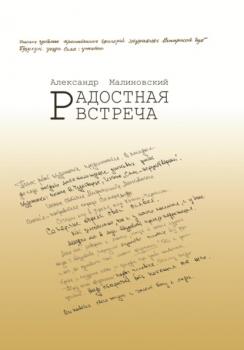Автор
Все книги издательства АвторThe alien visitor's revelation
Александр Александрович Воробьёв
Dear friends! My name is Alexander Alexandrovich Vorobyev, I live in Kaluga (Russia) and I am the author of “The alien visitor’s revelation” book series – book one, book two, book three, book four and book five, which narrate about the alien visitor, who reveals the secrets of the Space and Earth while travelling to other cosmic civilizations together with me.
Две пантеры
История о жизни Ларисы Пантериной так похожа на истории жизни многих женщин. Особенно в тот тяжелый период, как сейчас принято говорить, «лихих 90-х». Тогда каждому приходилось выживать. И каждый это делал так, как умел. В чем-то эта история автобиографична. В чем-то образ главной героини – собирательный, вобравший отдельные характерные черты многих моих знакомых. Да и мои тоже. Таким же собирательным получился и образ «вещевого рынка» эпохи 90-х. По сути, он стал тем местом работы, которое позволило многим не умереть с голода, не свести счеты с жизнью, удержаться на плаву, забыв про гордость и амбиции. «Вещевым рынком» для кого-то оказался маленький продуктовый магазинчик, студенческое общежитие, где можно было мыть полы или работать вахтером, ларек с разным товаром от продуктов до мыла и шампуней. Такие в те годы появлялись, как грибы после дождя. К счастью, мои подруги и знакомые, которые стали прототипами героини, выдержали испытания. Нашли свой путь и сложили свою судьбу.
Радостная встреча
Александр Станиславович Малиновский
В середине 60-х годов XX века появились первые публикации об удивительном самоучке художнике-иконописце, крестьянине Григории Журавлёве из самарского села Утёвка, родившемся без рук и ног и писавшем иконы, зажав кисть в зубах. Открыл его миру Александр Станиславович Малиновский, который в те годы начал собирать материалы о своём удивительном земляке. Он успел поговорить с людьми, лично знавшими Журавлёва, и сумел отыскать его иконы. С тех пор судьба художника-иконописца во многом вела самого писателя. В поисках новых сведений он работал в архивах Москвы, Самары, посетил Троице-Сергиеву Лавру, Санкт-Петербург и его главные музеи, побывал во многих уголках России, где находил сведения о Журавлёве и иконы, которые тот написал. Так, по мере накопления материала, складывалась эта книга.
Урок Россиеведения от Сергея Доренко
В этой книге история, озвученная Сергеем Доренко в эфире трех радиопередач "Урок Россиеведения" в марте-апреле 2015 года о том, как Владимир Путин пришел к власти и какие события произошли в России за время его правления. По мнению автора этот материал заслуживает литературной записи и отдельного осмысления. Это и послужило причиной для расшифровки эфира и переложения его на бумагу. Все, что описано в этой книге – это систематизация событий, рассказанных Сергеем Доренко в эфире тех трех эфиров на радио "Говорит Москва".
Инсталляция
История разрушенных отношений, через которую герой пересматривает своё отношение к женщинам. Влюблённости, случайные связи и попытка понять суть отношений между мужчиной и женщиной.
Основы бизнеса
Основа бизнеса – это продукт, нравящийся потребителю и визуально, и по качеству, и по цене. В основе создания привлекательного продукта – пирамида Маслоу: чем ценнее потребности, которые удовлетворяет продукт, тем лучше для вашего бизнеса. Надежные партнерские связи. Партнеры стоят на втором месте после клиентов. Их нужно тщательно отбирать и работать только с лучшими из них.
Пряный глоток Венеции
Настенька не спит с мужчинами, она – примерная жена и мать. Но раз в неделю ее захватывает короткое наваждение, где есть только мы. В этот раз я подарил ей ощущения от незабываемой Венеции, которые она испила до последней капли. Основано на реальных событиях.
Твое последнее лето
Александр долго не возвращался в родной захудалый городок, и на то были причины. В детстве он вместе с другом пережил там нечто жуткое, что преследовало его в кошмарах многие годы. Но продажа бабушкиной квартиры приводит его обратно, чтобы вновь испытать на прочность. Что произошло на колхозных полях тринадцать лет назад? Что за звероголовые идолы выбрались из земли и почему все, кто рискнул попросить их о помощи, пропали без следа?Александр думал, что самое страшное с ним уже произошло, пока не оказался решающей фигурой в борьбе с самым настоящим демоном.
Дятлов Посох. Книга вторая
После захватывающих приключений в Навьем мире Аня не может найти себе места, ведь она потеряла там друга, верного говорящего кота Вениамина. Неожиданно кот находится, и палитра ее жизни снова окрашивает серую повседневность новыми яркими мазками. Судьба сталкивает Аню и кота Вениамина с их старыми заклятыми врагами, близнецами Жаном и Жаком, юными неофитами тайного могущественного Ордена. Близнецов сопровождают их проводники, два злобных волка Ральф и Рольф. Впереди Новый год и новые смелые и непредсказуемые приключения. И конечно, зловещий барон с его неизменной спутницей, обворожительной злодейкой Гертрудой. Они замышляют коварный план, которому предстоит противостоять нашим отважным героям и их верным друзьям. И конечно же, без Бабы Яги в этот раз тоже не обойдется.
Куда пропали бутерброды?
Детективное агентство "Мухи" не дремлет. На этот раз пропали бутерброды. Удастся ли мухам помочь человеку найти воришку?









